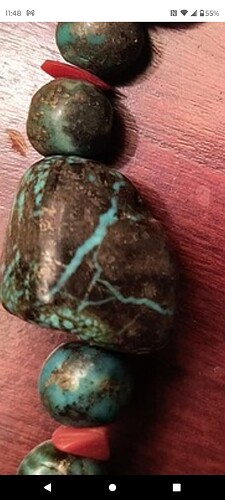Well now, that would make some heavy rings ![]()
This is the ring…
Is this considered boulder? It was sold to me as natural NV turquoise, and the store owner believed it was possibly Pilot Mountain. I’m really curious
@Ziacat Here’s my take on it: A Boulder turquoise cab is mostly visible host rock with a smattering of visible turquoise. I’m not considering the larger presence of host rock as matrix.
@Ziacat I wouldn’t describe that as Boulder turquoise, imo. I can see Pilot Mountain as a possibility.
Thanks! I think my confusion came from the fact that I mostly have seen ribbon turquoise, and I thought that was called boulder turquoise; I thought the names were interchangeable. I learn something new on here all the time!
right. i thought boulder turquoise was what they called it when it was mostly rock with a thin skin of turquoise, or mostly rock with small nodules showing. I thought Ribbon was a cutting (and marketing) technique used to maximize yield out of bits that were too thin of a vein to slice into decent faced stones. It’s just turquoise that’s been cut across a different axis of the host rock, like slicing a carrot into strips or coins.
One more question on boulder/ribbon turquoise, if this stone had been sliced differently, would it be considered ribbon turquoise? The back side of it has a little more turquoise showing (it’s a stone in one of my necklaces).
I’m sorry @redhead that your post has gone a bit off topic, but we all love to learn. Would you mind posting a pic of the piece that he called “bull-ger?”
@Ziacat My answer to your question is maybe but, this is only my opinion. A lapidary (and, I’m not one) may have been able to cut/slice your stone to where a singular “ribbon” of turquoise would be prominent in the cab (of mostly host rock). Maybe as a centered north-south turquoise ribbon or a ribbon running east-west. I think your question would best be answered by a lapidary.
ETA: @Jemez2 posted what I consider a very good explanation about ribbon turquoise.
IDK Ziacat, you might just call that one an example of “turquoise in matrix” since there’s more matrix than turquoise? Probably why it was tumbled for a bead rather than split or cut for cabs. the potential return in stone value vs. time invested in producing the output would not have made it worthwhile to try and cut it further. But, yes, if it was cut differently it could have been called ribbon, IMHO.
Thanks Patina and Jemez; I guess I’m curious. I haven’t seen a lot of boulder/ribbon turquoise so nice to learn about it.
@Jemez2 Thanks for your helpful input about Ribbon turquoise. From my online research, it seems like it’s pretty popular. I guess it does have a unique look.
it’s fascinating to me from a geology perspective how it grows - i mean, the ribbons are obviously from some mineral laden liquid filling in cracks in the stone matrix, and depositing what eventually turned into turquoise. but the itty bitty bubbly nodules suspended in what is now perfect spiderweb matrix, like, how did that grow? and the big CHUNGUS blocks of turquoise, with pyrite and quartz and blops of matrix and other things growing in it? just, in terms of geology, blows my mind.
Ribbon and boulder turquoise are naturally occurring but different things…they get used interchangeably. I personally like ribbon turquoise; the darker host rock makes the ribbon really stand out!
Sorry about the late response guys!
Here is one of the pieces my father referred to as “bul-ger”
I do know this is turquoise from a mine out west, bracelet made in the late 70’s, but he couldnt remember the name of the mine. He just always said “that’s bul-ger turquoise.” If there were any markings on the band, they are long gone after my mother wearing it so many years. So, another mystery piece




